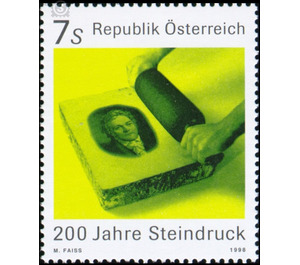200 years - Austria / II. Republic of Austria 1998 - 7 Shilling
Theme: Well-known people
| Country | Austria / II. Republic of Austria |
| Issue Date | 1998 |
| Face Value | 7.00 |
| Color | yellow green |
| Printing Type | offset |
| Stamp Type | Commemorative |
| Item Type | Stamp |
| Chronological Issue Number | 1589 |
| Chronological Chapter | OOS-OE2 |
| SID | 869998 |
| In 58 Wishlists | |
The inventor of lithography, this oldest lithographic printing process, was Alois Senefelder (born 1771 in Prague). He further developed this method, so that until today hardly anything has changed in the way of working. As a "printing block" a lime slate (Solnhofen limestone) is used. This "lithography stone" is ground, granulated and chemically prepared. The transfer of the print image is either photomechanically by copy or manually by the lithographer. Depending on the type of treatment, the lithographic stone has to be grease or water repellent. By rolling in with bold ink, the moistened stone takes on color only at the water-repellent point, while the remaining parts of the drawing remain without color. By Senefelder's successors, the application possibilities have been significantly expanded. Photographs, light printing or offset printing are, for example, inventions that are directly attributable to the further development of lithography.


